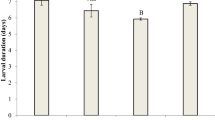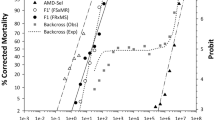Abstract
(1) The genetics of malathion resistance in two strains of the flour beetle, Tribolium castaneum, was investigated. In CTC-12, resistance is polygenic, while in Kano, it is due to a dominant allele at a single autosomal locus. Reciprocal hybrids with the susceptible control strains bb and pp showed an overdominant response in particular when Kano was the male parent in the original cross. (2) Three possible genetic mechanisms to explain these results are discussed. The model which best explains the genetic results, particularly the difference between the reciprocal crosses, assumes a modifier resistance allele on the Y chromosome. (3) The levels of activity of total esterases, carboxyesterases, mixed-function oxidases, epoxide hydrase, and glutathione transferase in the parent strains and their hybrids were measured quantitatively. Although total esterase activity may not be relevant for the breakdown of malathion, it was inhibited by the pesticide. The activity of the microsomal enzymes was high in CTC-12, low in bb, and intermediate in the hybrids, while carboxyesterases were very active in Kano as well as in the hybrids with bb and low in the latter. These patterns agree with the genetics of resistance in the two strains. A higher level of GSH transferase in the Kano×bb hybrids than in Kano seems to indicate a possible biochemical mechanism for their overdominant resistance.
Similar content being viewed by others
References
Baker, J. P. (1977). Assessment of the potential for and development of organophosphorous resistance in field populations of Myzus persicae. Ann. Appl. Biol. 861.
Baker, J. P. (1978). Electrophoretic studies on populations of Myzus persicae in Scotland from March to July 1976. Ann. Appl. Biol. 881.
Beranek, A. P., and Oppenoorth, F. J. (1977). Evidence that the elevated carboxyl-esterase (Esterase-2) in organo-phosphorous resistant Myzus persicae (Sulz.) is identical with the organophosphate-hydrolyzing enzyme. Pest. Biochem. Physiol. 716.
Champ, B. R., and Campbell-Brown, M. (1970a). Insecticide resistance in Australian Tribolium castaneum. I. A test method for detecting insecticide resistance. J. Stored Prod. Res. 653.
Champ, B. R., and Campbell-Brown, M. (1970b). Insecticide resistance in Australian Tribolium castaneum. II. Malathion resistance in Eastern Australia. J. Stored Prod. Res. 6111.
Cohen, E. (1981). Epoxide hydrase activity in the flour beetle Tribolium castaneum (Coleoptera, Tenebrionidae). Comp. Biochem. Physiol. 69B29.
Cohen, E., Sverdlov, E., and Wool, D. (1976). Expression of esterases during ontogenesis of the flour beetle, Tribolium castaneum (Tenebrionidae, Coleoptera). Biochem. Genet. 15253.
Crow, J. F. (1957). Genetics of insect resistance to chemicals. Annu. Rev. Entomol. 2227.
Dyte, C. E. (1970). Insecticide resistance in stored-products insects with special reference to Tribolium castaneum. Trop. Stored Prod. Inform 2013.
Dyte, C. E., and Rowlands, D. G. (1968). The metabolism and synergism of Malathion in resistant and susceptible strains of Tribolium castaneum. J. Stored Prod. Res. 4157.
Dyte, C. E., Green, A. A., and Pinniger, D. B. (1974). Some consequences of the development of insecticide resistance in stored-product insects. Proceedings, 1st International Working Conference on Stored Products Entomology, Savannah, Georgia, pp. 261–271.
Georghiou, G. P. (1969). Genetics of resistance to insecticides in houseflies and mosquitoes. Exp. Parasitol. 26224.
Georghiou, G. P., and Pasteur, N. (1980). Organophosphate resistance and esterase pattern in a natural population of the southern house mosquito from California. J. Econ. Entomol. 73489.
Georghiou, G. P., and Taylor, C. (1977). Operational influences in the evolution of insecticide resistance. J. Econ. Entomol. 70653.
Georghiou, G. P., Pasteur, N., and Hawley, M. K. (1980). Linkage relationships between organophosphate-resistance and a highly active esterase-B in Culex quinquefasciatus from California. J. Econ. Entomol. 73301.
Lowry, O. H., Rosebrough, N. J., Farr, A. L., and Randall, R. J. (1951). Protein measurement with the Folin phenol reagent. J. Biol. Chem. 193265.
O'Brien, R. D. (1967). Insecticide Action and Metabolism Academic Press, New York.
Oesch, F., Jerina, D. M., and Daly, J. (1971). A radiometric assay for hepatic epoxide hydrase activity with (7-3H)styrene oxide. Biochim. Biophys. Acta 227685.
Omura, T., and Sato, R. (1964). The carbon monoxide-binding pigment of liver microsomes. J. Biol. Chem. 2392370.
Pasteur, N., and Georghiou, G. P. (1980). Analysis of esterases as a means of determining organophosphate resistance in field populations of Culex mosquitoes. Proceedings, 48th Annual Conference, California Mosquito and Vector Control Association, January 1980, pp. 74–77.
Singh, R. S., and Morton, R. A. (1981). Selection for malathion resistance in Drosophila melanogaster. Can. J. Genet. Cytol. 23355.
Sokoloff, A. (1966). The Genetics of Tribolium and Related Species, Academic Press, New York.
Sokoloff, A. (1977). The Biology of Tribolium, Vol. III, Oxford University Press, New York.
van Asperen, K. (1962). A study of housefly esterases by means of a sensitive colorimetric method. J. Insect Physiol. 8401.
von Rümker, R., Guest, H. R., and Upholt, W. M. (1970). The search for safer, more selective, and less permanent pesticides. Bio Sci. 201004.
Wool, D., and Manheim, O. (1980). Genetically-induced susceptibility to malathion in Tribolium castaneum despite selection for resistance. Entomol. Exp. Appl. 28183.
Author information
Authors and Affiliations
Rights and permissions
About this article
Cite this article
Wool, D., Noiman, S., Manheim, O. et al. Malathion resistance in Tribolium strains and their hybrids: Inheritance patterns and possible enzymatic mechanisms (Coleoptera, Tenebrionidae). Biochem Genet 20, 621–636 (1982). https://doi.org/10.1007/BF00483961
Received:
Revised:
Issue Date:
DOI: https://doi.org/10.1007/BF00483961




